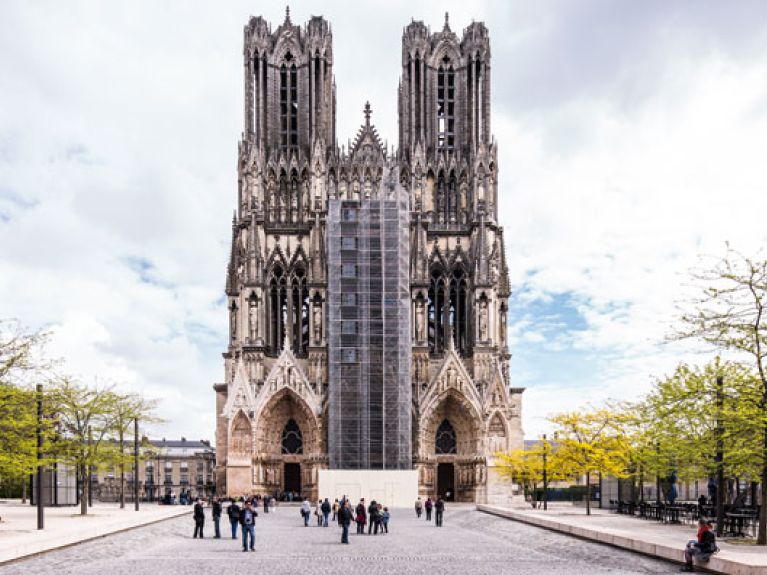A place of glass fragments and light
Nowhere else is Franco-German history as concentrated as it is in Reims Cathedral.

Can a place contribute to reconciliation? Of course, first and foremost it is people who keep memories alive and work together towards a peaceful future. In some cases, however, a building can also become a place of hope, a symbol of the transition from the past to the future and the central stage for current events. Reims Cathedral is such a place. Nowhere else is Franco-German history as concentrated as it is in this church – a history of enmity and a history of friendship.
The catastrophe that led to both countries being inextricably linked to this place came to pass in the autumn of 1914. German soldiers took the cathedral under heavy shelling – fully aware that the building was a national landmark. For centuries, the kings of France had been crowned there. The attack, which set the roof of this masterpiece of Gothic architecture on fire, served the sole purpose of humiliating the enemy. In those early days of the First World War, Reims thus came to epitomise the barbarism and wanton destructiveness of war. This city in north-eastern France also holds considerable symbolic significance with respect to the Second World War: Colonel General Alfred Jodl signed the document sealing Germany’s unconditional surrender at the Allied headquarters in Reims on 7 May 1945.
A church service with special significance
Some 17 years later, Reims began gradually to transform itself from a symbol of horror into a place of healing. On 8 July 1962, French President Charles de Gaulle and German Chancellor Konrad Adenauer took part in a service of reconciliation in the cathedral – a first, cautious rapprochement six months before the two countries signed the Treaty of Friendship at the Élysée Palace in 1963. Fifty years after the meeting in Reims, François Hollande and Angela Merkel came to the cathedral to renew their promise to cooperate.
Beyond such grand political gestures, the paths of the two countries have also crossed in the cathedral in recent times. France commissioned the German artist Imi Knoebel to design some of the high windows behind the altar in celebration of the church’s 800th anniversary in 2011. It is hard to imagine anything more symbolic: a German being given the opportunity to immortalise himself in this place that the French people associate with such pain and such violation, a place where the senselessness of war is just as obvious as in nearby Verdun with its seemingly endless lines of gravestones.
How the church windows combine art with faith
Imi Knoebel, it would appear, made no attempt to show humility in his work. His six stained-glass panes, covering a total area of 115 square metres, are explosions of colour – shining, fragmenting, sparkling arrangements of unequally-sized pieces. They light up the room and give a sense of disruption; they are at once beautiful and unsettling. Knoebel chose powerful nuances of red, yellow and blue for the individual elements. Light pervades the interior of the cathedral as if through burning fragments of glass. With bright colours and sharp cuts the artist draws attention to the horror that took place here, and in so doing does, after all, exhibit a certain humility.
All the same, many people questioned whether it is appropriate to place a modern, unashamedly colourful and highly individual work in a church as steeped in history as Reims Cathedral is – especially a work that is so far removed from church art. Knoebel’s windows resemble none of the others in the cathedral. Some of the stained glass windows date back to the Middle Ages and have been restored, while others were designed later by artists. Many depict bible stories or the heavy toil of winegrowers in the Champagne region around Reims. Three panes designed by Marc Chagall occupy a central place in the expansive church at the end of the nave. In soft blue tones, they portray stories from the Old and New Testaments. Framed on both sides by Imi Knoebel’s expressive works, it would have been easy to fear that they would be overshadowed, yet this is precisely what did not happen: instead, the powerful colours of Knoebel’s panes also shed Chagall’s windows in a new light.
Through Imi Knoebel’s images, the cathedral has become home to art that may not be political but most certainly is humanistic, art that itself has become part of this living monument. This creates an appropriate and exhortatory backdrop for future Franco-German encounters in this special place.
